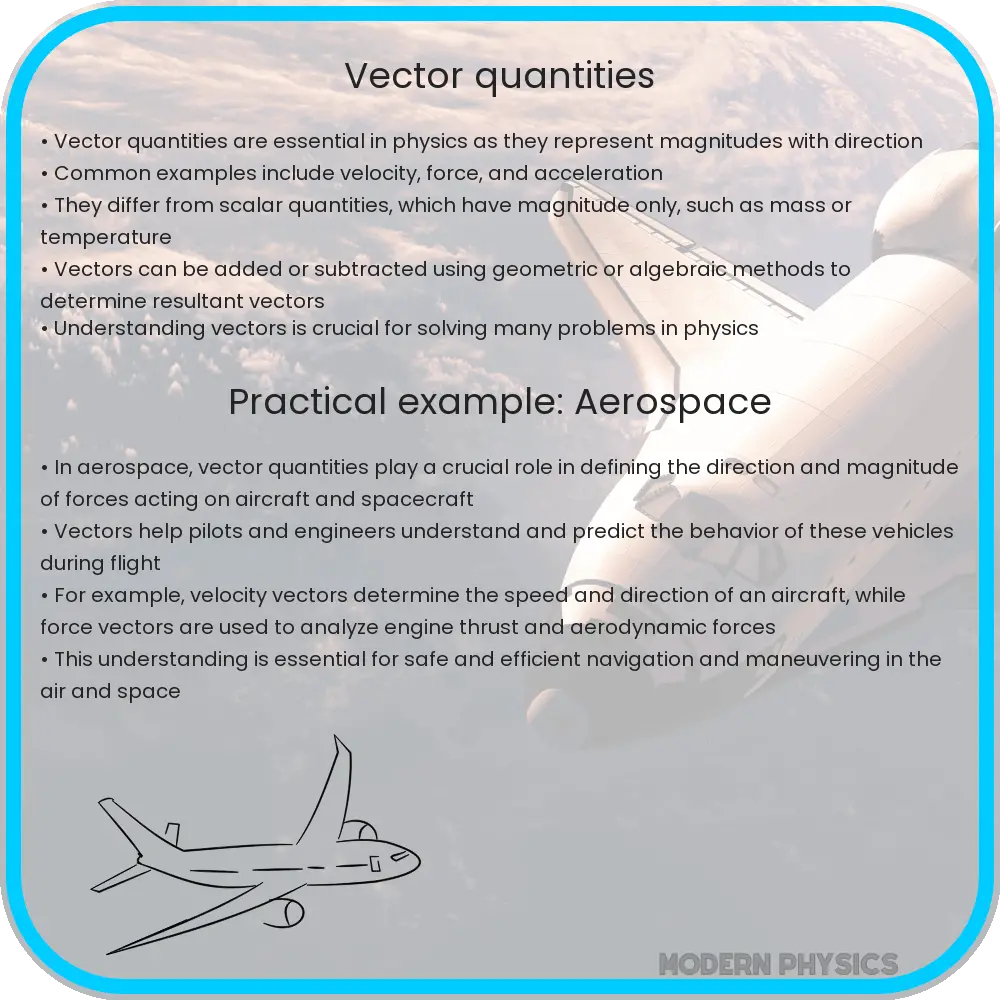Explore the essentials of vector quantities in kinematics, covering displacement, velocity, acceleration, and their real-world applications.

Understanding Vector Quantities in Kinematics
Kinematics, a branch of classical mechanics, involves the study of motion without considering the forces that cause it. A fundamental concept in kinematics is the use of vector quantities. Vectors are mathematical objects used to represent physical quantities that have both magnitude and direction. This contrasts with scalar quantities, which have magnitude but no direction.
The Role of Vector Quantities in Kinematics
Vector quantities are crucial in accurately describing the motion of an object. They help in understanding how objects move in a two-dimensional or three-dimensional space. The most common vector quantities in kinematics include displacement, velocity, and acceleration.
- Displacement: Displacement is a vector that represents the change in position of an object. It is defined as the shortest distance from the initial to the final position of an object and is represented as a straight line connecting these two points.
- Velocity: Velocity is a vector quantity that describes the rate of change of displacement. It includes both the speed of the object and the direction of its motion. Average velocity is calculated as the total displacement divided by the total time taken.
- Acceleration: Acceleration is the rate at which an object’s velocity changes with time. Like velocity, it is a vector quantity since it has both magnitude and direction. Acceleration can be due to a change in speed, a change in direction, or both.
Direction and Magnitude in Vectors
Every vector quantity has two principal characteristics: direction and magnitude. The direction of a vector describes the line of action and is often represented using angles or compass directions. The magnitude, on the other hand, signifies the size or quantity and is a scalar value.
For instance, if a car moves 50 kilometers east, its displacement is a vector. The ’50 kilometers’ is the magnitude, while ‘east’ specifies the direction.
Application of Vector Quantities in Real-World Scenarios
Understanding vectors is vital in various fields beyond physics. For example, in engineering, vector concepts are used in designing and analyzing structures and machinery. Pilots use vector principles to navigate aircraft, considering wind speed and direction for accurate travel paths. In sports, analyzing the motion of balls or athletes involves understanding vectors for performance improvements.
Moreover, vector calculations are essential in advanced fields like robotics and space exploration, where precision in movement and trajectory is critical.
In summary, vector quantities provide a comprehensive way to describe motion in kinematics, essential for a wide range of applications from basic physics to complex engineering systems.
Advanced Concepts in Vector Kinematics
Delving deeper into vector kinematics, we encounter concepts like relative velocity and projectile motion. Relative velocity is the velocity of an object as observed from a particular frame of reference. It is crucial in understanding scenarios where multiple objects are in motion, such as two cars moving on a highway. Projectile motion, another key aspect, involves objects moving under the influence of gravity, following a curved trajectory. This concept is vital in sports like basketball or in ballistic calculations.
Mathematical Representation of Vectors
Vectors can be represented mathematically in several ways. The most common is the Cartesian coordinate system, where a vector is described by its components along the x and y (and z, if in three dimensions) axes. This representation allows for the application of algebraic methods to solve kinematic problems. For instance, the velocity vector \(\mathbf{v} = v_x \mathbf{i} + v_y \mathbf{j}\) has components \(v_x\) and \(v_y\) along the x and y axes, respectively.
Challenges and Solutions in Vector Analysis
One of the challenges in vector analysis is visualizing and solving problems in three dimensions. Advanced techniques, such as vector projection and cross-product, are used to address these challenges. Vector projection helps in analyzing the component of one vector along the direction of another, which is crucial in work and energy calculations. The cross-product, on the other hand, finds applications in determining the area of parallelograms formed by vectors and in calculating torques.
Conclusion
Vector quantities play an indispensable role in understanding and describing kinematic phenomena. Their unique characteristic of possessing both magnitude and direction enables a more comprehensive and realistic representation of physical realities. From simple motion in a straight line to complex three-dimensional movements, vectors provide the necessary tools to analyze and solve a wide array of problems in kinematics. This understanding not only forms a foundation for advanced studies in physics and engineering but also finds practical applications in everyday life, from navigation to sports analytics. Thus, the study of vector quantities in kinematics is a fundamental and vital part of the broader scientific endeavor to comprehend and harness the laws of motion that govern our world.
